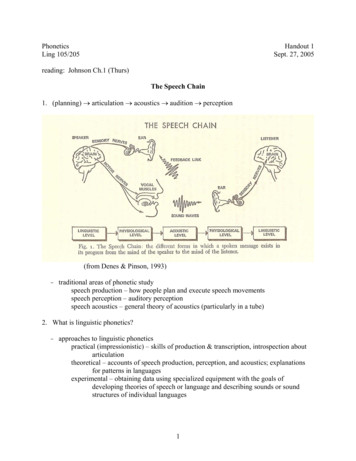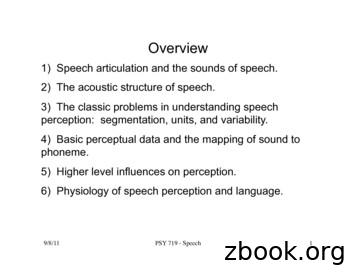Theories Of Speech Perception
Theories of Speech Perception Motor Theory (Liberman)– Close link between perceptionand production of speech Use motor information tocompensate for lack ofinvariants in speech signal Determine which articulatorygesture was made, inferphoneme– Human speech perception isan innate, species-specificskill Because only humans canproduce speech, onlyhumans can perceive it as asequence of phonemes Speech is special Auditory Theory– Derives from generalproperties of the auditorysystem– Speech perception is notspecies-specific
Wilson & friends, 2004 Perception/pa//gi/BellBurst of white noise Production/pa//gi/Tap alternate thumbs
Wilson et al., 2004 Black areas are premotorand primary motor cortexactivated when subjectsproduced the syllables White arrows indicatecentral sulcus Orange represents areasactivated by listening tospeech Extensive activation insuperior temporal gyrus Activation in motor areasinvolved in speechproduction (!)
Wilson and colleagues, 2004
Is categorical perception innate?
Manipulate VOT, Monitor Sucking
4-month-old infants: Eimas et al. (1971)20 ms20 ms(Different Sides) (Same Side)0 ms(Control)
Is categorical perception speciesspecific? Chinchillas exhibit categorical perceptionas well
Chinchilla experiment(Kuhl & Miller experiment)“pa pa pa pa ”“ba ba ba ba ”
Train on end-point “ba” (good), “pa” (bad) Test on intermediate stimuli Results:– Chinchillas switched over from staying torunning at about the same location as theEnglish b/p phoneme boundary
VOT “identification” by chinchillas(Kuhl & Miller, 1981)
Categorical perception, Take 2 Natural discontinuities in many sensorysystems; many of these are commonacross mammalian species Some stimulus differences are hard;others are easy Language takes advantage of “naturalboundaries”
Categorical Perception &Auditory Theory Categorical perception may arise fromrapid decay of auditory memory– not unique to speech People have some ability to discriminatesounds within a phoneme– judgments may reflect decision process ratherthan perception
Motor Theory versusAuditory Theory Close link between speech perception andspeech production systems– Motor Right! Some properties of speech perception (e.g.categorical perception) general auditoryproperties– Auditory Right! Speech perception probably not innate speciesspecific– Motor Wrong
Comprehension Recognize Word– Phonological Info– Visual Info Retrieve Information– Syntactic Info– Semantic/Pragmatic Info Integrate Syntactic & Semantic/Pragmatic Info Store Gist Representation
Word Recognition Serial– Comprehensioninvolves analysis atseveral different levelsin turn Interactive– Various sourcesinteract and combineto produce efficientanalysisSerialInteractive
Bottom-up Processes Acoustic InfoPhonetic InfoPhonemic InfoWords & Sentences
Top-Down Processes To what extent does knowledge of what speakeris saying impact processes necessary forunderstanding speech?
Phonemic Restoration Effect Legislature Sentences
McGurk Effect
McGurk EffectLips say “ba” /ba/ bilabial /ga/ velar /da/ dentalSound signal “ga”Subjects hear “da”
What’s the relevance? What does this stuff have to do withinteractive vs. serial models? Context Effects– Interactive Models use all sources ofinformation for rapid word ID– Serial Models inefficient & slow
Marslen-Wilson’s Cohort Model Mentalrepresentations ofwords activated (inparallel) on the basisof bottom-up input(sounds) Can be de-activatedby subsequent input– bottom-up(phonological)– top-down (contextual)
Uniqueness and Recognition When we hear the beginning of a word this activates ALLwords beginning with the same sound: the “word initialcohort”. Subsequent sounds eliminate candidates fromthe cohort until only one remains (failure to fit with contextcan also eliminate candidates)t- tea, tree, trick, tread, tressle,trespass, top, tick, etc.tr- tree, trick, tread, tressle, trespass,etc.tre- tread, tressle, trespass, etc.tres- tressle, trespass, etc.tresp - trespass.
Uniqueness and Recognition The uniqueness point is the point at which aword becomes uniquely identifiable from itsinitial sound sequenceE.g. “dial”dayl UP“crocodile”krokod aylUP For non-words there is a deviation point: a pointat which the cohort is reduced to zeroE.g. “zn owble” would be rejected with a faster RT than “thousaj ining”DPDP
Uniqueness and Recognition The recognition point is the point at which,empirically, a word is actually identified Empirical studies show that recognition pointcorrelates with (and is closely tied to) theuniqueness point.– phoneme monitoring latencies correlate with a prioricohort analysis (and one way to recognise word initialphonemes is to recognise the word and to know itbegins with e.g. /p/)
Cohort Model(Marslen-Wilson & Tyler) Words consistent withinput become active– Cohort – set of wordsconsistent with first syllable Words in the cohorteliminated when theybecome inconsistent withinput Words eliminated due tocontextual incongruity Processing ends whenthere is one word left inthe cohort/ka/cat captain catchcapitalism/kap/captain capitalismCommunism is slightlydifferent from /kap/capitalism
Marslen-Wilson & Tyler NormalThe church was broken into last night.Some thieves stole most of the lead off the roof. SyntacticThe power was located in green water.No buns puzzle some in the lead off the text. RandomIn was great power water the located.Some the no puzzle buns in lead text the off.
Marslen-Wilson & 500Monitoring Time
Activation in the Revised antcaptaintimecaptivecaptin
TRACE Like the interactive-activationmodel of printed wordrecognition, TRACE has threesets of interconnecteddetectors– Feature detectors– Phoneme detectors– Word detectors These detectors span differentstretches of the input (featuredetector span small parts,word detectors span largerparts)The input is divided into “timeslices” which are processedsequentially.
Phoneme boundary12PdetectorPPBdetector.3456PPPP.789PP.BBB
If there are feature detectors, can we tire one of them out?
Selective adaptation1. Do phoneme identification test(e.g., “ba-pa” continuum)2. Play a stimulus from one of the endpoints many times (e.g., 100 times)3. Repeat phoneme identification test
Selective adaptationPre-adpatationphonemeboundary% “ba” -100 -90 -80 -70 -60 -50 -40 -30 -20 -10 0 10 20 30 40 50 60“pa”“ba”REPEAT -100 “ba”100 times for one minuteVoice Onset Time continuum
The power was located in green water. No buns puzzle some in the lead off the text. Random . model of printed word recognition, TRACE has three sets of interconnected detectors – Feature detectors – Phoneme detectors – Word detectors These detectors span different
1 11/16/11 1 Speech Perception Chapter 13 Review session Thursday 11/17 5:30-6:30pm S249 11/16/11 2 Outline Speech stimulus / Acoustic signal Relationship between stimulus & perception Stimulus dimensions of speech perception Cognitive dimensions of speech perception Speech perception & the brain 11/16/11 3 Speech stimulus
The Speech Chain 1. (planning) articulation acoustics audition perception (from Denes & Pinson, 1993) -traditional areas of phonetic study speech production – how people plan and execute speech movements speech perception – auditory perception speech acoustics – general theory of acoustics (particularly in a tube) 2.
9/8/11! PSY 719 - Speech! 1! Overview 1) Speech articulation and the sounds of speech. 2) The acoustic structure of speech. 3) The classic problems in understanding speech perception: segmentation, units, and variability. 4) Basic perceptual data and the mapping of sound to phoneme. 5) Higher level influences on perception.
Tactile perception refers to perception mediated solely by vari- ations in cutaneous stimulation. Two examples are the perception of patterns drawn onto the back and speech perception by a "listener" who senses speech information by placing one hand on the speaker's jaw and lips
SOCIAL PSYCHOLOGY 63-81 Learning Objectives 63 Key Terms 63 Role Theories 65 Motivational Theories 67 Learning Theories 69 Cognitive Theories 73 Symbolic Interaction Theories 75 Socio-Cultural Theories 77 Evolutionary Theories 78 Summary and review 80 review QueStionS 81 4. SELF AND IDENTITY 82-107
Contents Foreword by Stéphanie Ménasé vii Introduction by Thomas Baldwin 1 1 The World of Perception and the World of Science 37 2 Exploring the World of Perception: Space 47 3 Exploring the World of Perception: Sensory Objects 57 4 Exploring the World of Perception: Animal Life 67 5 Man Seen from the Outside 79 6 Art and the World of Perception 91 7 Classical World, Modern World 103
2 S o c i a l T h e o r i e s Theories can be used to study society—millions of people in a state, country, or even at the world level. When theories are used at this level they are referred to as macro-level theories, theories which best fit the study of massive numbers of people (typically Conflict and Functional theories).
speech 1 Part 2 – Speech Therapy Speech Therapy Page updated: August 2020 This section contains information about speech therapy services and program coverage (California Code of Regulations [CCR], Title 22, Section 51309). For additional help, refer to the speech therapy billing example section in the appropriate Part 2 manual. Program Coverage























